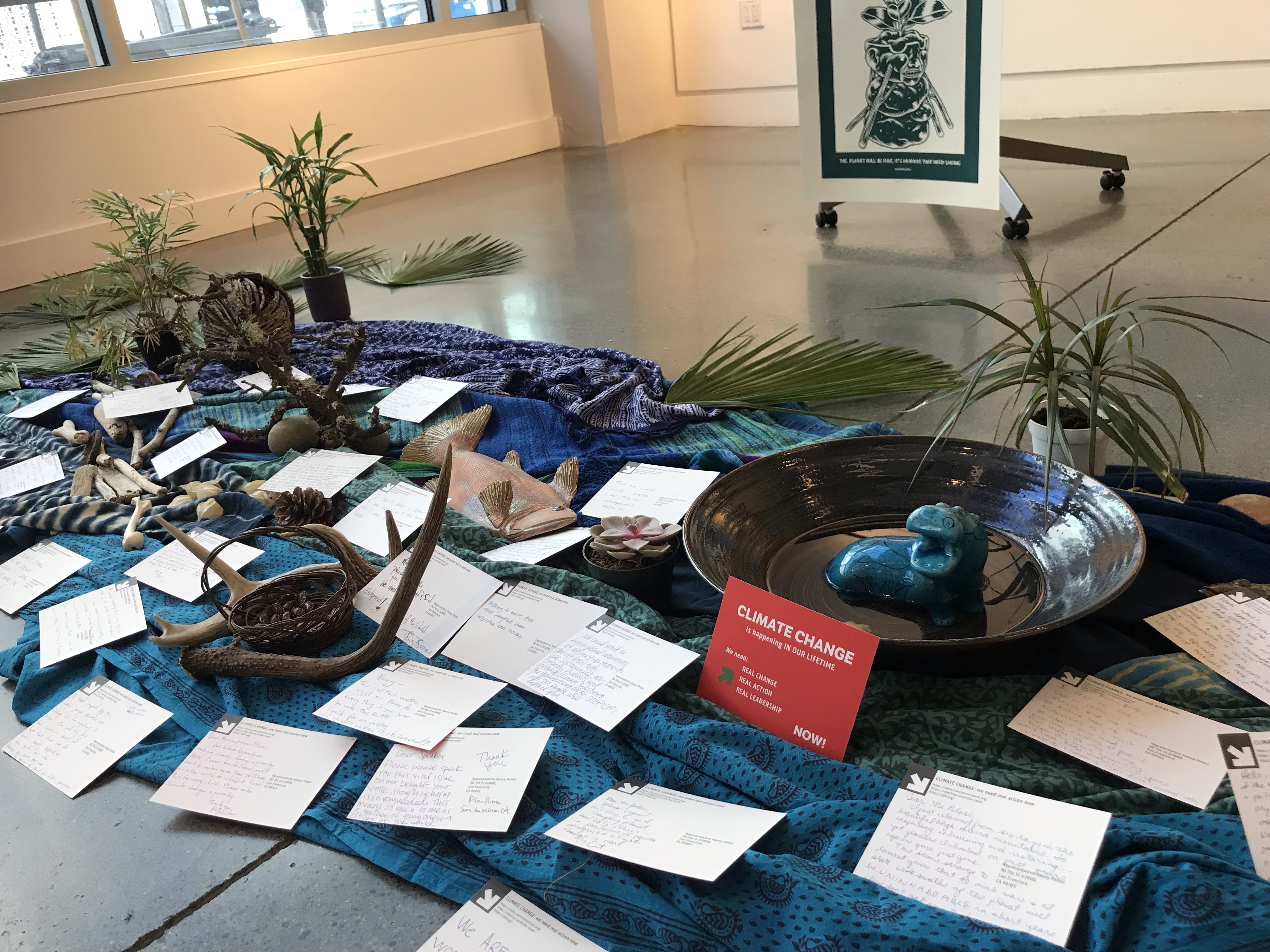The Increasing Relevance of Eco Chaplaincy
Gesshin Claire Greenwood | October 8, 2019
In the last few weeks, over six million people around the globe have protested climate disaster. On Friday, September 20, 2019 over two million people walked out of their schools or workplaces.
On that day, my professor and schoolmates helped stage a small climate change ceremony in the lobby of the California Institute of Integral Studies, where I am studying to become a therapist. We constructed an “earth altar” on the floor out of scarves, cloth, stones, bone, plants, and bowls of water. After guiding people to be aware of their bodies, we invited participants to write their feelings about climate change on postcards. In particular, I asked the participants to think about something they would like to mourn: a species of animal, perhaps, or the ice caps. A way of being, a future foreclosed. Then, Buddhist priests chanted a sutra while each person brought their card to the altar. Afterward, we mailed the cards to Nancy Pelosi’s office.
As a Buddhist clergy member, therapist in training, and the Chaplaincy Program Coordinator here at IBS, I often wonder what my role will be in the coming years of climate disaster. I do know a large part of this work will be helping people come to terms with grief.
Daigan Gaither, an alum of IBS’ Buddhist Chaplaincy Program, also participated in the event by chanting sutras and holding space for participants.
“Our practice as Buddhists and chaplains calls us to not turn away from reality,” he explained. “Our work is to face head-on the suffering of this climate disaster as well as the way it ties into systems of racism, sexism, classism, and other oppressions.”
 Shmee Giarratana, who also helped lead the ceremony, also noted the connection between spirituality and environmental activism, “The beautiful altar and grief ritual was an honorable way to be in mourning, and encouraged a ‘being with’ the emotional experience rather than ‘contemplating’ the loss. The chanting of the sutra viscerally changed the energy of the whole space, which helped my experience of ‘being with’ the grief in deeper ways. Integrating the postcards for Nancy Pelosi into the ritual empowered the voice and action that is elevated by our prayer. It felt like an interweaving of several ways to approach the enormity of climate change.”
Shmee Giarratana, who also helped lead the ceremony, also noted the connection between spirituality and environmental activism, “The beautiful altar and grief ritual was an honorable way to be in mourning, and encouraged a ‘being with’ the emotional experience rather than ‘contemplating’ the loss. The chanting of the sutra viscerally changed the energy of the whole space, which helped my experience of ‘being with’ the grief in deeper ways. Integrating the postcards for Nancy Pelosi into the ritual empowered the voice and action that is elevated by our prayer. It felt like an interweaving of several ways to approach the enormity of climate change.”
Coined by Sarah Vekasi in 2005, “eco chaplaincy” refers to work that supports social movements and activists fighting to preserve the environment. In a similar way that a chaplain working in a hospital, prison, or school tends to the spiritual needs of patients who are suffering, chaplains can also tend to the needs of communities, displaced populations, or entire social justice movements. Disaster chaplaincy—chaplaincy for victims of natural disasters— is also increasing in relevance as our world experiences more floods, fires, and extreme weather.
Many opportunities exist for students to develop their understanding of eco-chaplaincy and disaster chaplaincy. The Chaplaincy Innovation Lab offers an online course in “movement chaplaincy,” for those interested in spiritually aiding social movements. The Sati Center, who has an institutional partnership with IBS, offers a year-long course in eco-chaplaincy, “environmentally based spiritual care” that includes spiritual counseling, environmental justice work, nature-based rituals, and ceremonies for mourning ecological death. The National Organization for Victim Assistance offers online and in-person training in crisis response, which includes instruction in how to mitigate trauma and stabilize communities.
I believe Buddhist chaplaincy will become increasingly important in a world marked by climate disaster. Buddhist leaders are particularly adept at being with suffering, impermanence, and loss, as well as holding together the paradoxes of despair and hope, grief and resilience.